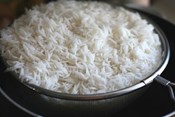With the aid of high-tech tools, Agriculture Research Service (ARS) and collaborating scientists are closing in on the genes in rice that regulate the uptake and storage of important minerals; a pursuit that could bolster the nutritional value of this cereal grain crop as a staple food for roughly half the world’s population.
Ultimately, the team envisions bio-fortifying rice using traditional plant breeding methods to develop new varieties whose kernels (grain) boast exceptionally high concentrations of essential minerals, including zinc, iron, and calcium.
Rice is a mainstay of the human diet for good reason. It is a rich source of energy, free of gluten (which causes allergic reactions in some individuals), easy to digest, low in fat, and packed with vitamins, minerals, and other nutrients. Some key elements, however, like iron, are lost when the bran on brown rice is stripped off during milling to produce so-called white rice. More than 70 percent of rice eaten in the US is enriched. Thiamine, niacin, iron, and folic acid have been added to the outside surface of the uncooked white kernels to bring the overall nutritional value up to that same as or higher than that of the wholegrain version (brown rice).
While the U.S. enriches rice, developing countries where rice is a mainstay, do not fortify the grain after milling. In addition, the soils in which the crop is grown may also be lacking in some essential minerals. For populations that rely on rice as a staple food, low levels of iron, zinc, or other minerals can lead to nutritional deficiencies that manifest as fatigue, poor immune system function, and other symptoms. In fact, more than 3 billion people worldwide suffer from iron or zinc deficiencies in their diets.
To address these concerns, scientists with ARS and their colleagues at various universities have focused their studies on three different groups of rice with over 1,500 genetic lines that have been collected from 114 countries around the world. In this diverse group, the researchers have found rice genetic lines that contain up to nine times the amount of minerals normally observed in standard U.S. varieties.
They are mapping DNA of the various lines and crossbreeding them with the hopes of developing a variety that will be suitable for growth in the U.S. that will have higher concentration of needed minerals. So far, in side-by-side comparisons, researchers have developed 40 genetic lines that have higher levels of minerals that are important not only to human health, but also to the that of the rice plant. One example being Calcium.
More information on this topic can be found in the Agriculture Research Magazine’s May/June Issue in an article written by Jan Suszkiw of ARS. Cornell Cooperative Extension of Fulton and Montgomery Counties provides equal program and employment opportunities.





